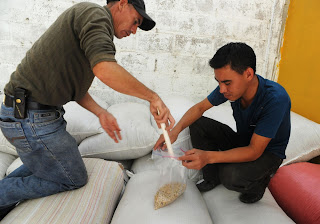April in La Unión marks the end of the coffee harvest, as
farmers gather the last coffee cherries from the trees. At UMF’s processing and
training facility (beneficio), we’ve finished processing coffee for the season,
and we’ve bought and received at the warehouse more than 67,000 lbs. of dried coffee.
What happens to the coffee beans after they are processed and dried? How did we
determine which coffees to buy? And what are the next steps for getting the
delicious beans to roasters and coffee drinkers in the U.S.? This blog post
will give an overview of the process of getting coffee from a farmer to a coffee
cup.
Coffee sampling
 |
| Gilberto and Pedro take a coffee sample. |
To get this accuracy, a UMF field officer (Gilberto, Martir
or Pedro) goes to the farmer’s house to personally take the sample. They use a
hand-made tool to take a small sample from each sack of dried coffee, and they
collect it in a gallon-sized sealable bag. That way, if even one sack contains
damaged coffee, it will be apparent from the sample. The field officers code each
sample and mark down identifying information for the farmer and field. Then,
they bring the sample to the office for roasting preparation.
Sample preparation
 |
| Yoshi prepares a coffee sample for roasting. |
The beans now have had the papery shell removed, and are a
green-blue color (thus it is referred to as green coffee at this stage). The
next step is to sort (manually) the good beans from damaged beans. Once sorted,
we can determine how much would be lost due to defects, and how much green
coffee we would end up with to sell after the parchment is removed (during
export preparation). If you’d like to read more about this process, visit this
blog post
We take additional measurements, such as the humidity of the
parchment and green coffee, to ensure that the coffee has been properly dried
and prepared. Finally, the good green beans are sealed in an air-tight plastic
bag and are ready for roasting.
Coffee roasting
In order to taste the coffee, it must be carefully roasted.
We use a light roast for samples because it reveals the most flavors present in
the coffee. All of the roasts must be consistent in time and temperature to
ensure that any taste differences come from the coffee itself, and not because
of how it was roasted.
UMF has a small roaster that we use for roasting the
samples. Before, we would have to travel two hours away on a
bus to get the samples roasted. By having a small roaster in La Unión, we are
able to taste the samples and reply to farmers much sooner.
Cupping samples
 |
| Multiple cups are used to test taste consistency. |
Purchasing and
Receiving
 |
| Yoshi weighs incoming coffee at the warehouse. |
Non-purchased Coffees
Although we would like to purchase coffee from every farmer
we work with, we can only buy the best coffees since we are paying a premium
price. UMF does not purchase coffee that receives a cupping score below 85. If
a coffee is not purchased, we make sure to tell the farmer the reason for our
decision – maybe they fermented the coffee too long, or did not sort out
overripe beans – so that they can work to improve the quality in future
harvests. Some farmers who are dedicated to producing quality coffee, but are just
starting with new picking and processing techniques, have brought us samples
for three years before meeting our quality standards.
Export Preparation
and Export
 |
| Beneficio Santa Rosa |
Roasting and
packaging
This coffee has traveled from La Unión, Honduras, to Indiana,
and from there it is distributed to coffee roasters, coffee shops, restaurants,
churches and homes in the U.S. We sell a portion of the coffee in its green
form to coffee roasters, and we also sell roasted coffee. (See this link to get some delivered to your house!) Coffee from this year’s harvest has
already begun its journey to the U.S. – we can’t wait to share it with you!
